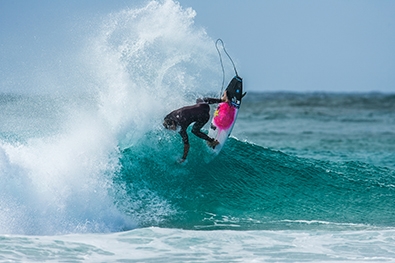Words Nick Carroll
Demonstration by Jack Freestone at a Goldie beachbreak, sequence by Andrew Shield.
An excerpt from Surfing Life 312, Pacific Playgrounds.
OK, that’s it.
I’ve been looking at surf pics for most of my life, and until now it’s never really struck me –the idea that some of us may now be doing a completely different sport.
I don’t mean because of the wave. It’s piss-easy to make things look crazy that way; or if it isn’t exactly piss-easy, it’s pretty damn obvious. Relocate yourself into something 20’high, 25’wide and 10’thick, or just go to Indo and fluke your way into an 8’bomb at Scar Reef or wherever, and you don’t really have to DO anything else –just hang. Draw the right line. That’s a messed-up wave, but that’s surfing.
It’s not the board either. You can ride retro-style craft, but again, it won’t be anything unusual. It’s just a way of reducing the demands on your skills. Which might leave some more room for good ol’fun, until you get bored…but it’s still recognisable as the thing we consider surfing to be.
But stuff like this massive nose pick by Jack. It’s just not in the same realm is it? You can’t just go out and DO it.
Or… can you? Let’s have a closer look at the mad dynamics of the sequence and see if we can grasp what it’s telling us.
THE BREAKDOWN
So shot one, the move actually looks conventional enough, bottom turn leading up the face into what appears to be about to turn into a hacking backside top turn. Except for the track. Look closely
kiddies, and you’ll see how Jack hasn’t reset the rail at all. There’s no direction change going on, at least not on the axis implied by the term “top turn”. Instead, shot two, Jack’s popped the whole board flat off the curve of the lip and lets it spin around an axis centred around a spot between his shoulder blades. For a moment, the wave has ceased to matter.
Shot four, the big one, is the payday –but before you go there, look at the pic just before it. There’s something about Jack’s back foot, toes clenched around the rail, that reveals a key control point. The rest of his body is supremely relaxed, but those toes, they’re curled up like a fruitbat’s hanging off a branch. Just a nice little counterpoint in the midst of a move turning red.
Then the nose lands and goes a foot underwater. And here’s where the different sport seems to begin. Pretty much all surfing theory and practice, the way people stand on boards, the kinds of waves people seem to wanna ride, the way boards are designed, the way styles have developed for bloody ever, have been built around the notion of a nose and a tail. That’s why we have tail pads. That’s why we surf offset, choosing goofy or natural. That’s why three fins work. That, in short, is the fucken game.
And yet in shot four, and in the wild gymnastics of the recovery, Jack’s mega move is saying to us, No. That’s not all the game. The nose can be the tail. The tail can be where the nose once went. The wave can be three foot. Stall with this bit, pop with that bit, carve with some other bit. Worry about making it once you’ve done it.
THE LESSON
Surfing’s not done. Like it is soooo far from done. We here at SL are great appreciators of classical surfing style and technique, but we cannot help but feel that it is kind of done to death. Ride a retro board and perfect your knock-knee cutback –take off and go straight on a big wave –great! These things are filled with pleasure. Yet the more often the same moves are repeated over and over, as if they were somehow new, the more our surfing minds are stuck with ’em, and the less we can claim surfing as being a truly creative act. Moves like Jack’s break open that mould and suggest to us that new things really are possible –that the wave is there to be investigated, that the board will do things we haven’t yet tried, because there are things we haven’t yet designed or done or imagined.
This is the heart of surfing. And you could do this move tomorrow. You’ve just gotta see it.
Like what you’re reading, and want to read more? Click here.



